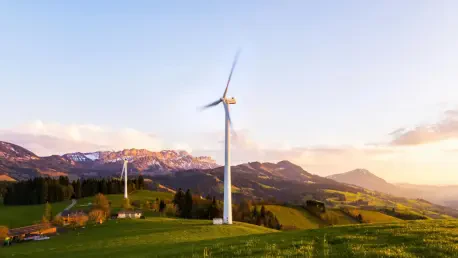Romania is making remarkable strides toward a sustainable energy future, positioning itself as a significant player in Europe’s renewable energy landscape through ambitious wind power initiatives. With the urgent need to combat climate change and reduce reliance on fossil fuels, the country has embarked on a transformative journey by partnering with leading international firms to harness wind energy on a massive scale. This development not only promises to bolster energy security but also aims to stabilize prices for consumers while cutting down on harmful emissions. The collaboration between Danish wind giant Vestas and Eurowind Energy stands as a testament to Romania’s commitment to green innovation. Their joint efforts are set to bring substantial capacity to the national grid, paving the way for cleaner air and a more resilient energy system. As global trends push toward decarbonization, Romania’s proactive approach serves as a compelling example of how strategic partnerships and technological advancements can drive environmental and economic progress.
Harnessing Wind for a Sustainable Future
Romania’s push for renewable energy has taken a significant leap forward with the announcement of three major wind power projects—Frumusita, Vector, and Pecineaga Northeast. These initiatives, totaling a capacity of 143 megawatts, are poised to become operational by the second half of 2026, delivering a substantial boost to the country’s clean energy portfolio. Spearheaded by Vestas in collaboration with Eurowind Energy, the projects will deploy 23 state-of-the-art V162-6.2-megawatt turbines from the EnVentus platform. This cutting-edge technology underscores the focus on efficiency and scalability, ensuring that wind power can meet growing energy demands. Beyond the environmental benefits, such as reducing greenhouse gas emissions, these developments align with broader national goals of achieving energy independence and fortifying grid stability. The strategic timing of these projects also coincides with upcoming regulatory reforms and incentives that are expected to further accelerate renewable energy adoption across the region.
Another key aspect of this initiative is its role in addressing air pollution and stabilizing energy costs for Romanian consumers. Wind power, as a clean and renewable resource, offers a viable solution to mitigate the environmental impact of traditional fossil fuel-based energy systems. The deployment of these large-scale projects will contribute significantly to reducing reliance on non-renewable sources, which often lead to price volatility due to geopolitical tensions or supply chain disruptions. Additionally, the integration of wind energy into the national grid supports efforts to modernize infrastructure, making it more adaptable to fluctuations in demand. Industry leaders have expressed optimism about the long-term impact of this transition, noting that sustained investment in renewables can create a more predictable and affordable energy market. This shift not only benefits the environment but also lays the groundwork for a more equitable energy future, where access to clean power becomes a cornerstone of national policy.
Overcoming Challenges with Innovation
While wind energy presents immense potential, it is not without challenges, particularly the issue of intermittency caused by inconsistent wind patterns that can disrupt power supply. However, Romania’s latest projects are accompanied by advancements in energy storage technologies and smart grid systems that are designed to tackle this drawback effectively. These innovations allow for better management of energy production, storing excess power during high-wind periods for use when generation dips. Such solutions are critical to ensuring that wind power remains a reliable component of the energy mix, even as it scales up to meet national needs. The focus on technological integration highlights a broader trend in the renewable sector, where persistent hurdles are being addressed through ingenuity and investment. As these systems become more sophisticated, they pave the way for wind energy to play a central role in a sustainable and stable power grid.
Equally important is the economic dimension of these wind power initiatives, which extend far beyond environmental gains. Vestas, a dominant force in Romania’s wind sector, already oversees more than 1.5 gigawatts of capacity either installed or under construction, alongside over 1.2 gigawatts under service. The company’s extensive local presence, including five service hubs and a regional training center, supports over 550 jobs, demonstrating the tangible benefits to the workforce. This economic ripple effect strengthens communities by providing stable employment and fostering skill development in a high-growth industry. Statements from industry figures like Morten Gaarde of Eurowind Energy and Srdan Cenic of Vestas emphasize the trust and collaboration that underpin these projects, reflecting a shared vision for progress. The synergy between international expertise and local implementation serves as a model for how renewable energy can drive both ecological and economic transformation on a national scale.
Building a Legacy of Energy Security
Looking back, Romania’s commitment to wind power through these landmark projects marked a defining moment in its journey toward sustainability. The successful collaboration between Vestas and Eurowind Energy showcased how international partnerships could amplify local efforts to transition away from fossil fuels. Each turbine installed and every megawatt added to the grid represented a step closer to cleaner air and a more resilient energy infrastructure. The economic benefits, from job creation to skill enhancement, further underscored the multifaceted impact of this shift. Reflecting on these achievements, it became clear that strategic investments in renewables had laid a strong foundation for long-term energy security.
Moving forward, the focus should remain on scaling up such initiatives while continuing to innovate in energy storage and grid management. Policymakers and industry stakeholders must prioritize sustained funding and regulatory support to maintain momentum. Exploring additional renewable sources to complement wind power could further diversify the energy mix, reducing risks associated with over-reliance on a single resource. As Romania solidified its position in Europe’s clean energy landscape, the lessons learned from these projects offered valuable insights for other nations aiming to balance environmental goals with economic growth. The path ahead demanded adaptability and collaboration, ensuring that the legacy of these efforts endured for generations.









